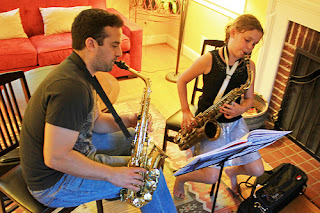I'm back to teaching piano lessons this new semester. I like many methods of teaching. One approach I've been using is from Carol Tornquist. More specifically, her easy play method is about:
- Notation - eventually reading 4 octaves (including sharps, flats and ledger lines)
- Theory - necessary for a full understanding of making music (emphasis on intervals, chords, keys, and harmony)
- Melody - beginning on 3 black keys (L.H. and R.H.), then moving to C position (5 fingers) and other key groups.
- Rhythm - beginning with a simple meter (2/4, 3/4, 4/4) and an introduction of a compound meter 6/8.
- Chords - introduced I, V7, eventually using major, minor, diminished, augmented chords (block and broken)
- Keys - use of all major and minor key signatures, the order of sharps and flats.
- Accompaniment - Use harmonic intervals, then 3 note chords.
- Creativity - writing melodies, "questions"/"answers", harmonies for melodies.
- Transposition - encouraged to help students think in "keys"
- Technique - ear training exercises.
By Level 1 and 2, my students know some music definitions. Here's just a few:
- D.C. al Fine - To go back to the beginning and play until Fine.
- Forte - Loud
- Transpose - To play in a different key
- Mezzo Piano - Medium Soft
Many boys and girls have learned some Italian words to describe TEMPO. For example:
- Fast - Allegro
- Medium Tempo - Moderato
- Andante - Slow
Level 1 Fundamentals
Introducing Patriotic songs for Level 1 students helps them to hear the interval distance. For example in the Key of F when they play America the Beautiful, students hear the first melodic interval, which is a 6th, from Middle C up to A.
Introducing Patriotic songs for Level 1 students helps them to hear the interval distance. For example in the Key of F when they play America the Beautiful, students hear the first melodic interval, which is a 6th, from Middle C up to A.
So, kids have learned that an Interval is a DISTANCE between one note and another and that there are two kinds on Intervals: Learn Intervals
- Melodic: 2nd (C to D), 3rd (C to E), 4th (C to F), and 5th (C to G)
- Harmonic 2nd (C and D together), 3rd (C and E together), 4th (C and F together), and (C and G together).
- An interval of a 7th is either: line to line (G to F) or space to space (F to E).
When students learn about half steps and whole steps, they start listening to tones. Many enjoy playing the Chromatic Scale at this time.
- Half Steps - A Half Step is the shortest melodic interval there is on the keyboard. In other words, it's the distance from one key to the next... black or white... up or down. For example G to F#, E to F. C to C#, and E to Eb.
- Whole Steps - A Whole step is a distance from one key to another, with just one key between them. For example G down to F, E to F#, C to D, and E down to D.
All ages on different levels like to practice scales, especially the C Major Scale. Every Major Scale has 8 notes grouped into a "pattern" of half steps and whole steps. Sliding your thumb under your 3rd finger on "F", play the C Major Scale from C to C (ascending). Then try it going down (descending) crossing your 3 rd finger over your thumb on E. One of the most well-known Christmas carols begins with the Major Scale descending, and that is "Joy to the World" by George F. Handel.
Many junior high students are writing their own songs using broken chords. In the Key of C, you play 3 major chords:
C Major (I) = C-E-G
F Major (IV) = F-A-C
G Major (V) = G-B-D
Children and adults enjoy listening to seventh chords, hearing how they are alike or different. Many play 3 Dominant Seventh Chords in Level 1. History of Seventh Chords
G7 (C Major) - BFG
D7 (G Major) - F#CD
C7 (F Major) - EBbC
When a chord changes from one to another, it's called a Chord Progression. To help with more improv skills, one must learn left-hand patterns and chord inversions.
Remember that the I chord is also known as the Tonic. C root position = CEG
Also, the IV chord is called the Subdominant. (FAC)
And that the V chord is also known as the DOMINANT. (GBD)
Subdominant Chord Inversions
Root = FAC
1st = ACF
2nd = CFA
Root = FAC
Dominant Chord Inversions
Root = GBD
1st = BDG
2nd = DGB
Root = GBD
The Dominant Seventh chord is formed by adding the "7th" above the "root." (GBDF)
Since the Dominant Seventh chord has 4 notes in it, you may leave out 1 note and still have a triad:
BFG.
Hope this helps. Keep practicing... I know I will!
Blessings!
Many junior high students are writing their own songs using broken chords. In the Key of C, you play 3 major chords:
C Major (I) = C-E-G
F Major (IV) = F-A-C
G Major (V) = G-B-D
Children and adults enjoy listening to seventh chords, hearing how they are alike or different. Many play 3 Dominant Seventh Chords in Level 1. History of Seventh Chords
G7 (C Major) - BFG
D7 (G Major) - F#CD
C7 (F Major) - EBbC
When a chord changes from one to another, it's called a Chord Progression. To help with more improv skills, one must learn left-hand patterns and chord inversions.
Remember that the I chord is also known as the Tonic. C root position = CEG
Also, the IV chord is called the Subdominant. (FAC)
And that the V chord is also known as the DOMINANT. (GBD)
Subdominant Chord Inversions
Root = FAC
1st = ACF
2nd = CFA
Root = FAC
Dominant Chord Inversions
Root = GBD
1st = BDG
2nd = DGB
Root = GBD
The Dominant Seventh chord is formed by adding the "7th" above the "root." (GBDF)
Since the Dominant Seventh chord has 4 notes in it, you may leave out 1 note and still have a triad:
BFG.
Hope this helps. Keep practicing... I know I will!
Blessings!
-- LadyD
"The beautiful thing about learning is that no one can take it away from you." B.B.King




















![Validate my Atom 1.0 feed [Valid Atom 1.0]](valid-atom.png)







